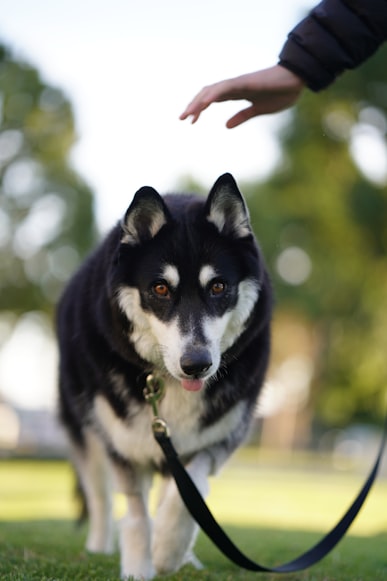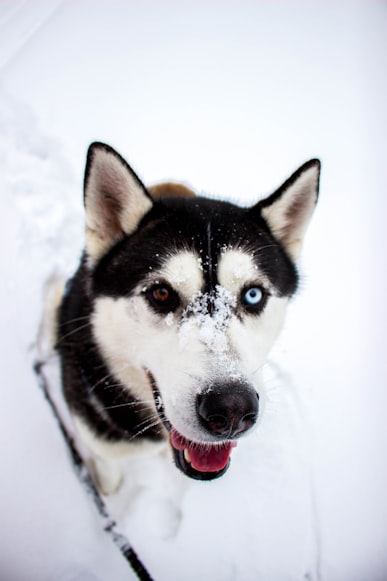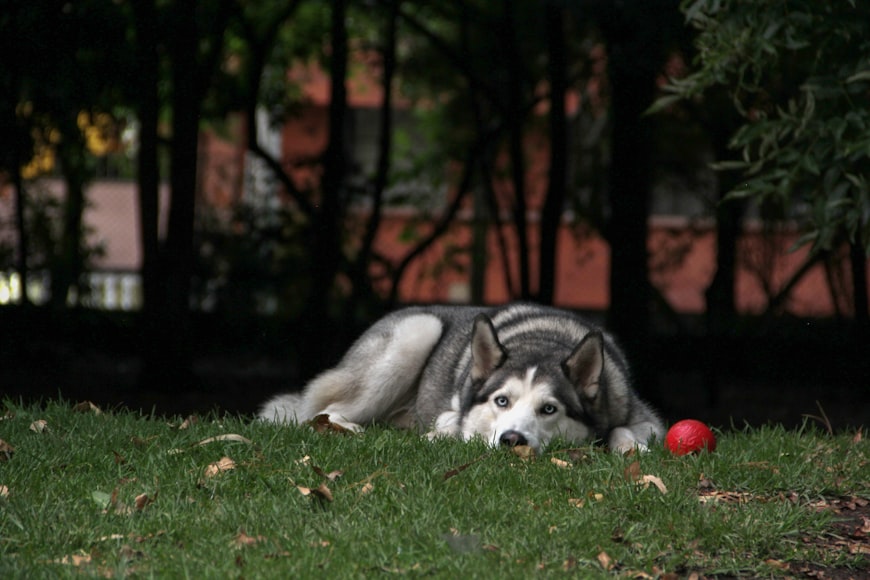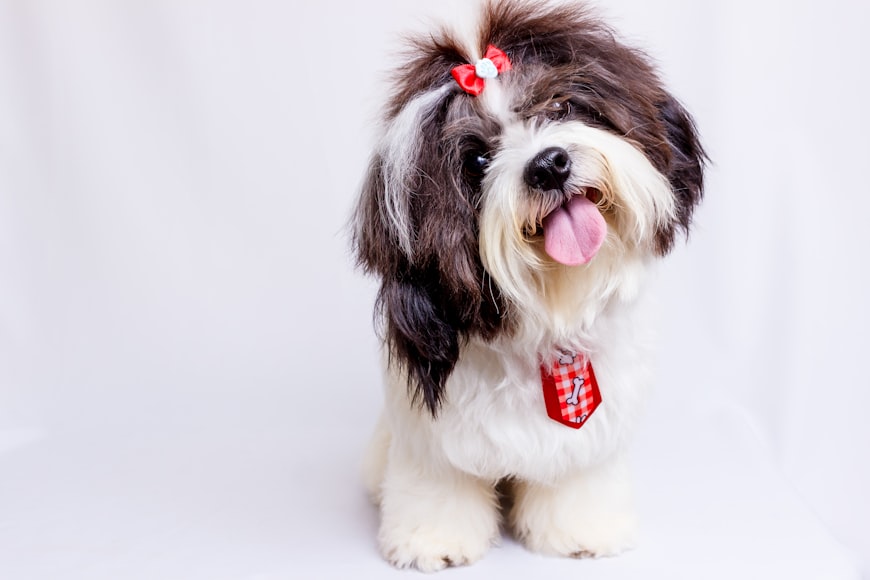II. Physical Characteristics

A. Appearance
Siberian Huskies are famed for their striking appearance, marked by their piercing blue eyes, thick double coat, and wolf-like demeanor. Here are the salient physical attributes of these mesmerizing canines:
1. Eyes:
Their piercing blue eyes, or sometimes brown or hazel, are a signature characteristic of Huskies. These almond-shaped eyes exude an air of intelligence and alertness.
2. Ears:
Erect, triangular ears stand atop their heads, providing them with exceptional hearing capabilities. The black tips on the ears add to their wolfish allure.
3. Head:
Huskies have a broad head with a well-defined muzzle and a black “mask” that accents their eyes.
4. Body:
Their athletic build, characterized by a muscular frame and a slightly elongated body, allows them to traverse vast distances with ease.
5. Tail:
The bushy tail, often carried high like a flag, serves as a rudder for balance and a warm covering in cold climates.
6. Coat:
The double coat of a Husky is a marvel of adaptation. The dense undercoat provides exceptional insulation, while the longer, coarser guard hairs repel water and protect from the elements. The coloration can vary greatly, ranging from white to black, with markings in between.
B. Size and Weight
The size and weight of a Siberian Husky can vary depending on factors such as gender and genetics. Here’s a general overview:
1. Height:
Males typically stand between 21 to 23.5 inches (53 to 59 cm) tall at the shoulder, while females are usually between 20 to 22 inches (51 to 56 cm).
2. Weight:
The ideal weight for male Huskies is around 45 to 60 pounds (20 to 27 kg), and for females, it’s between 35 to 50 pounds (16 to 23 kg).
Conclusion:
The physical characteristics of the Siberian Husky Dog contribute to their captivating allure. Their striking appearance, combined with their athleticism and endurance, make them both visually impressive and functional working dogs. Whether it’s their piercing eyes, wolfish demeanor, or dense double coat, every aspect of their physique reflects their unique heritage and purpose.
III. Temperament and Behavior

A. Personality
Siberian Huskies are known for their striking appearance, but they also possess a captivating personality. They are typically friendly, playful, and outgoing dogs that love to be around people. Huskies are known for their “wolf-like” nature, which includes a keen intelligence and a strong pack instinct.
-
Friendly and Social: Huskies are highly social creatures that enjoy interacting with people and other dogs. They are not known for being aggressive or aloof.
-
Playful and Energetic: Huskies are full of energy and love to play. They are highly active dogs that require plenty of exercise and mental stimulation to stay happy and healthy.
-
Independent and Stubborn: Huskies are independent thinkers and can sometimes be stubborn. They require patient and consistent training to learn obedience and follow commands.
-
Vocal and Talkative: Huskies are known for their vocal nature. They are often talkative dogs that express their emotions through howling, whining, and barking.
B. Intelligence and Trainability
Siberian Huskies are highly intelligent dogs, but they can also be challenging to train. They have a strong sense of independence and can be stubborn at times. However, with patient and consistent training, Huskies can learn to be obedient and responsive.
-
Intelligence: Huskies are highly intelligent dogs that are capable of learning complex tasks and commands. They excel at problem-solving and can be quite resourceful.
-
Trainability: Huskies can be challenging to train due to their independent nature. They require positive reinforcement and patient consistency. Once they are trained, however, they can be reliable and obedient companions.
Tips for Training Siberian Huskies:
- Start early: Begin training socialization and obedience as soon as possible.
- Be patient and consistent: Huskies require patience and repetition to learn.
- Use positive reinforcement: Reward Huskies for desired behaviors with treats, praise, or play.
- Keep training sessions short: Huskies can become bored quickly. Keep training sessions to around 5-10 minutes.
- Make training fun: Incorporate games and activities into training to make it more enjoyable for both you and your Husky.
- Seek professional help if needed: If you encounter significant challenges, consider seeking professional help from a certified dog trainer.
Conclusion:
Siberian Huskies are intelligent, affectionate, and playful dogs that can make wonderful companions for active and experienced owners. They are a vocal and social breed that requires plenty of exercise and mental stimulation to stay happy and healthy. With patient and consistent training, Huskies can be obedient and reliable dogs that will bring years of joy and companionship.
IV. Health and Care

A. Exercise Requirements
Siberian Huskies are highly active and athletic dogs that require a substantial amount of daily exercise to stay healthy and happy. A minimum of two hours of rigorous activity per day is recommended to prevent boredom, pent-up energy, and destructive behavior. This can include activities such as:
- Long walks or runs: Allow your Husky to explore on a leash or in a safe area off-leash.
- Dog parks: Supervised dog parks offer opportunities for Huskies to socialize and play with other dogs.
- Hiking or trail running: Adventure together on nature trails that provide mental and physical stimulation.
- Fetch or chasing games: Huskies love to chase and retrieve objects, which can provide excellent cardiovascular exercise.
- Agility or obedience training: Structured training classes offer both physical and mental challenges for your Husky.
B. Grooming Needs
Siberian Huskies have a double coat that requires regular grooming to maintain its health and beauty. Their outer coat is coarse and weather-resistant, while the undercoat is soft and insulating. Here are the key grooming requirements:
1. Brushing:
- Brush your Husky’s coat at least twice a week to remove loose hair, dirt, and debris.
- Use a slicker brush or undercoat rake to reach through the thick outer coat and remove the dense undercoat.
- During shedding seasons (twice a year), daily brushing is recommended to prevent mats and tangles.
2. Bathing:
- Huskies only need to be bathed every 4-6 weeks or as needed.
- Use a dog-specific shampoo and conditioner to avoid stripping their natural oils.
- Rinse thoroughly and towel dry or use a hairdryer on a low setting.
3. Nail Trimming:
- Trim your Husky’s nails regularly to prevent overgrowth and discomfort.
- Use a guillotine-style nail trimmer and take small cuts at a time to avoid cutting into the quick.
4. Ear Cleaning:
- Check your Husky’s ears weekly for any signs of infection or wax buildup.
- Use a cotton ball or gauze soaked in ear cleaner to gently remove any debris or excess wax.
5. Dental Care:
- Brush your Husky’s teeth regularly to prevent dental disease.
- Use a dog-specific toothbrush and toothpaste and brush at least three times per week.
Additional Health Considerations:
- Vaccinations: Keep your Husky up-to-date on vaccinations to protect them from preventable diseases.
- Parasite Control: Regularly check for and treat your Husky for parasites such as fleas, ticks, and heartworms.
- Hip and Elbow Dysplasia: Huskies are susceptible to hip and elbow dysplasia, which can lead to lameness and arthritis. Regular veterinary checkups and early detection are crucial.
- Eye Problems: Siberian Huskies can experience eye conditions such as cataracts and glaucoma, so regular eye exams are recommended.
By adhering to these health and care requirements, you can help your Siberian Husky live a long, healthy, and fulfilling life. Remember to consult with your veterinarian regularly for personalized advice and to address any specific health concerns.
VI. Training and Exercise

A. Basic Obedience: Establishing a Solid Foundation
Siberian huskies are highly intelligent and independent dogs, so establishing a strong foundation in basic obedience is crucial. Begin training as early as possible, using positive reinforcement methods such as treats, praise, and petting.
- Start with simple commands: Teach your husky basic commands like sit, stay, come, heel, and down. Use clear hand signals and verbal cues, and reward your dog for each correct response.
- Practice in various settings: Train your husky in different environments, such as the home, park, and on walks. This will help them understand commands regardless of distractions.
- Be consistent and patient: Training takes time and consistency. Be patient with your husky and reward them for progress, no matter how small.
B. Specialized Activities: Unleashing the Husky’s Spirit
In addition to basic obedience, Siberian huskies excel in specialized activities that tap into their natural instincts and physical prowess.
1. Sledding:
Siberian huskies were originally bred to pull sleds in the Arctic. Sledding is a great way to provide them with physical exercise while also engaging their working spirit. If you live in a snowy area, consider taking your husky out on a sledding adventure.
2. Agility:
Agility is a sport that tests a dog’s speed, coordination, and obedience. Huskies love to run and jump, so agility courses are a perfect outlet for their energy and athleticism. Start with basic obstacles like jumps and tunnels, and gradually increase the difficulty as your husky progresses.
3. Canicross:
Canicross is a combination of running and dog sledding. You and your husky are attached by a leash, and you run together. This activity is a great way to get both you and your dog in shape.
4. Bikejoring:
Similar to canicross, bikejoring involves attaching your husky to a bike. You can either ride solo or with a team of huskies. Bikejoring is a fast-paced and exhilarating way to enjoy the outdoors with your dog.
Exercise Requirements:
Siberian huskies are high-energy dogs that require plenty of exercise. Aim for a minimum of 1-2 hours of exercise per day, including a mix of physical activity and mental stimulation. Here are some ideas for keeping your husky active:
- Daily walks or runs
- Fetch or tug-of-war games
- Swimming or playing in the snow
- Interactive toys that encourage chasing or puzzle solving
Conclusion:
Training and exercise are essential aspects of a Siberian husky’s well-being. By establishing a solid foundation in basic obedience and engaging them in specialized activities, you can not only strengthen your bond but also provide a fulfilling life for your adventurous companion. Remember to be consistent, patient, and mindful of your husky’s unique needs and instincts.



















